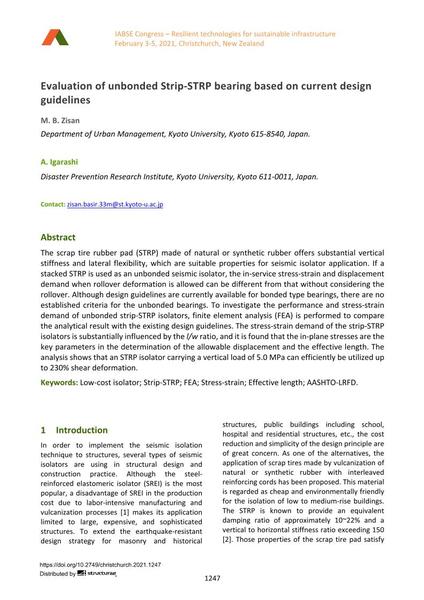Evaluation of unbonded Strip-STRP bearing based on current design guidelines

|
|
|||||||||||
Bibliographic Details
| Author(s): |
M. B. Zisan
(Department of Urban Management, Kyoto University, Kyoto 615-8540, Japan.)
A. Igarashi (Disaster Prevention Research Institute, Kyoto University, Kyoto 611-0011, Japan.) |
||||
|---|---|---|---|---|---|
| Medium: | conference paper | ||||
| Language(s): | English | ||||
| Conference: | IABSE Congress: Resilient technologies for sustainable infrastructure, Christchurch, New Zealand, 3-5 February 2021 | ||||
| Published in: | IABSE Congress Christchurch 2020 | ||||
|
|||||
| Page(s): | 1247-1256 | ||||
| Total no. of pages: | 10 | ||||
| DOI: | 10.2749/christchurch.2021.1247 | ||||
| Abstract: |
The scrap tire rubber pad (STRP) made of natural or synthetic rubber offers substantial vertical stiffness and lateral flexibility, which are suitable properties for seismic isolator application. If a stacked STRP is used as an unbonded seismic isolator, the in-service stress-strain and displacement demand when rollover deformation is allowed can be different from that without considering the rollover. Although design guidelines are currently available for bonded type bearings, there are no established criteria for the unbonded bearings. To investigate the performance and stress-strain demand of unbonded strip-STRP isolators, finite element analysis (FEA) is performed to compare the analytical result with the existing design guidelines. The stress-strain demand of the strip-STRP isolators is substantially influenced by thel/wratio, and it is found that the in-plane stresses are the key parameters in the determination of the allowable displacement and the effective length. The analysis shows that an STRP isolator carrying a vertical load of 5.0 MPa can efficiently be utilized up to 230% shear deformation. |
||||
| Keywords: |
FEA AASHTO LRFD Low-cost isolator Strip-STRP Stress-strain Effective length
|
||||
